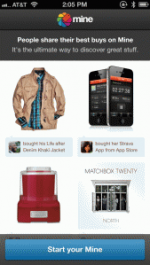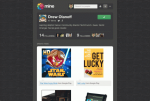
Today, a company simply called Mine is launching its online and mobile directory of people and purchases, backed by $600,000 in funding from Michael Dearing’s Harrison Metal. Using an email importer functionality as well as manual entry, Mine allows users to selectively share their online and offline purchases with their friends on the network, and those friends can then click through on the shares to learn more or to purchase the items for themselves.
The company was founded by former Product Marketing Manager at Twitter Pierre Legrain, alongside former LightSpeed Fellows Siddharth Batra, and Deepak Rao. Legrain says the idea for Mine came about around the time when he had just left Twitter, where he had focused on Twitter’s ad products: Promoted tweets, Promoted Trends, Promoted Accounts and analytics. “We spent some time looking at the Twitter firehose,” he says. You can get a sense for the purchase data people are already sharing if you search for “just bought,” for example, on Twitter today, Legrain explains. “There’s an incredible volume of people talking about products, and they tend to be talking about products in the context of having just bought them. They’re not talking about things they like or want – ownership and shopping is the main context for talking about products,” he adds.
Legrain says this discovery seemed to fly in the face of what a lot of people were saying about social media – that people don’t want to shop on Facebook, or talk about purchases with their friends, for instance. Even when looking through Instagram shares to Twitter, the team found that people were sharing photos of things they owned – gadgets, cars, shoes, clothing, etc.
The way the service works is similar in some sense to the mobile order tracking app Slice. Like Slice, Mine parses your email (Gmail or Yahoo) to find order confirmations. Currently, Mine supports Amazon, the Apple App Store, iTunes, Zappos and Etsy, but promises that list will grow in time. Additionally, users can enter any in other purchase they may have made into the search box on the site and Mine will attempt to locate the best place where you can buy it online. For example, you could enter in blue striped sweater from JCrew (not a real example) and Mine would look to find that item among JCrew’s current catalog.
The service doesn’t get everything right – after signing up with Facebook, but before connecting with Gmail, it appeared that Mine shared a book purchase. The timestamp would lead you to believe that I bought the book a couple of months ago, but the book has actually been on my shelf for years. The same thing occurred with a few apps. Many other apps are missing. And it appears that some products were shared before I gave them the green light, too. It would be helpful to see the source for these purchases (Facebook, Twitter? Email?), but Mine doesn’t offer that.
Fortunately for users, Mine isn’t using affiliate revenue to grow the business. “Our [product-matching search] technology tries to work out what the best link is, given the item you told us about,” explains Legrain, “and if we were doing an affiliate scheme, it would be corrupted by that process as we’d have to point to you to the best link we thought given the money we could make. That’s not the way we want to do it,” he says.
In other words, Mine is not currently being monetized. But Legrain insists that a directory of ownership offers “unique,” and “specific and new” ways to monetize its efforts, but declined to go into detail as to Mine’s plans.
Blippy Redux?
If all this sounds vaguely familiar, you’re right – a startup known as Blippy once tried to do something similar in terms of friends sharing their purchases with others. But Legrain explains that Blippy and Mine differ in a number of ways. Blippy relied on credit card purchase data, Mine does not, he says. Blippy shared data publicly, where Mine users approve each item shared. Blippy shared prices, Mine doesn’t. Blippy also treated purchases as line items, while Mine defaults to a more visual interface.
Blippy may have failed, but not because the core idea was rotten (seeing friends’ purchases for shopping inspiration), but because the implementation and mechanisms it used to get at that data were the wrong ones. “Blippy used credit card details. That’s a pretty heavy-handed thing to ask from a user,” says Legrain. “It was advantageous to Blippy but it was of no use – actually it was more work – for the user.”
But Blippy also failed to gain traction outside its early adopter user base because, for some folks, there’s something awkward and braggy about sharing lists of things you’re buying. Price or no price, it’s one thing to Instagram your fabulous new shoes, but posting the purchase on a site dedicated to posting purchases can cross that invisible line between sharing and showing off. Mine will need to tread carefully there.
Today, Mine is available online and as a mobile application for iPhone.




